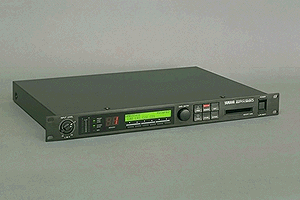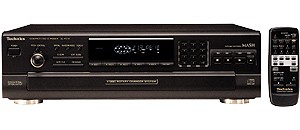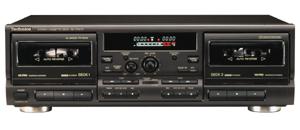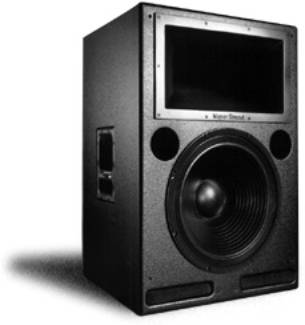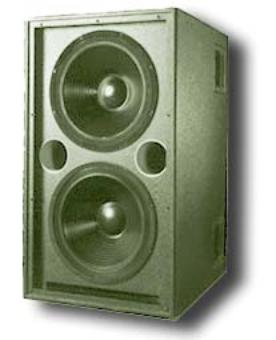Yamaha SPX-990 Digital Multi-Effect Processor
Advanced
Hardware for Superior Sound
|
The
latest 20-bit analog-to-digital and digital-to-analog conversion
technology- sampling at 44.1kHz. Frequency response extends all the way
from 20 Hz to 20 kHz; dynamic range is an extraordinary 106dB; noise and
distortion are neglible. |
Stereo Configuration with Balanced Inputs and Outputs
|
A true
2-in/2-out stereo configuration that allows stereo sources to be processed
without disrupting the original stereo image. Stereo inputs and outputs
are all electronically balanced, with XLR and TRS phone jack connectors. |
Preset, Internal, and Card Memory
|
180
memory locations "on board". 80 of these are read-only memory.
The remaining 100 are writable memory locations. Plug-in memory cards hold
an extra 100 effect programs each. |
Three-stage Effect Configuration
|
In
addition to the main effects, the SPX990 provides programmable pre and
post effects that can be used to refine and polish your sound. |
In-depth Programming Power
|
The
SPX990 has 4 programmable pre effects, 36 programmable main effects, and 3
programmable post effects. |
Tempo-based Delay Time Programming
|
Delay
time parameters can be programmed in terms of tempo or note length. Delay
time can also be entered via a footswitch or MIDI clock data. |
Superior Pitch Precision
|
The
SPX990 achieves faultless pitch tracking through a new dynamic waveform
analysis technique. In addition to the simple parallel pitch tracking the
SPX990's "intelligent" pitch change creates appropriate harmony
based on a specified key and scale type. |
External Parameter Control
|
The
SPX990 allows two selected parameters from each program to be assigned to
two external MIDI controllers. |
MIDI Control
|
The
SPX990 allows MIDI selection of all programs, and real-time control of up
to two selected effect parameters at the same time. |
4 Pre-Effects
|
1. 3-band
PEQ *1, 2. Compressor *1, 3. Harmonic Driver *1, 4. Compressor, Dist. and
EQ *3 *1= 2 IN - 2 OUT, *2 = 1 IN - 2 OUT, *3 = 1 IN, 1 OUT |
36 Main Effects: Reverb, Early Reflections, Delay and Echo, Modulation
|
REVERB:
Reveb *2, Filtered Reverb *2, Stereo Reverb *1, Echo Room *2; EARLY
REFLECTIONS: Thin Early Reflection *2, Fat Early Reflection *2, Gate
Reverb *2, Reverse Gate *2; DELAY and ECHO: Delay L, C, R *2, Echo *2,
Multi Tap Delay *2, Stereo Echo *1, Tempo Mono Echo *2, Tempo Stereo Echo
*1, Tempo Quad Echo *1; MODULATION: Flanger *1, Dual Flanger *1, FM Chorus
*1, AM Chorus *1, Phaser *1, Symphonic *1 *1= 2 IN - 2 OUT, *2 = 1 IN - 2
OUT, *3 = 1 IN, 1 OUT |
Main Effects continued: Pitch Change, Pan, Complex Effects, Freeze
|
PITCH
CHANGE: Mono Pitch Change *3, Dual Pitch Chance *2, Triple Pitch Chance
*2, Stereo Pitch Change *1; PAN: Auto Pan *2, Triggered Pan *2; COMPLEX
EFFECTS: Chorus and Reverb *2, Symphonic and Reverb *2, Flanger and Reverb
*2, Reverb (L) / Reverb (R) *1, ER (L)/ Reverb (R) *1, Echo (L) / Reverb
(R) *1, Chorus (L) / Reverb (R) *1, Pan (L) / Pan (R) *1; FREEZE: Freeze
*3 *1= 2 IN - 2 OUT, *2 = 1 IN - 2 OUT, *3 = 1 IN - 1 OUT |
3 Post Effects
|
1. 3-band
PEQ *1; 2. Compressor *1, Harmonic Driver *1 *1 = 2 IN - 2 OUT |
Manual: View manual on-line
Technics SLPD10 5 disc CD Changer Rack Mount:
|
|
||||||||||||||||||||||||||||||||
|
Technics RSTR575 Cassette Player – Rack Mount:
|
|
||||||||||||||||||||||
|
Furman PL8 Power Conditioner:

The PL-8 is an economical power conditioner for your rack.
| EMI/RFI AC line filtering for clean power and spike/surge protection to protect your gear | |
| 10-amp capacity with circuit breakers | |
| 2 retractable rack lights with dimmer to illuminate your racked gear | |
| 8 rear-mounted AC outlets controlled by front panel switch |
Shure SM81:
![]() The
Shure Model SM81 is a high-quality, unidirectional condenser microphone designed
for studio recording, broadcasting, and sound reinforcement. Its wide frequency
response, low noise characteristics, and low RF susceptibility have made it a
standard for applications involving acoustic instruments, especially guitar,
piano, and cymbals.
The
Shure Model SM81 is a high-quality, unidirectional condenser microphone designed
for studio recording, broadcasting, and sound reinforcement. Its wide frequency
response, low noise characteristics, and low RF susceptibility have made it a
standard for applications involving acoustic instruments, especially guitar,
piano, and cymbals.
The SM81 is ruggedly constructed.
It operates on phantom power and performs over a wide range of temperatures and
humidity conditions. It is furnished with a swivel adapter, attenuator-switch
lock, foam windscreen, and case for carrying and storage. Other accessories are
available.
| 20 Hz to 20 kHz frequency response | |
| Flat response curve for accurate reproduction of sound sources | |
| Low noise and high output clipping level | |
| Low distortion over a wide range of load impedances | |
| Cardioid polar pattern, uniform with frequency and symmetric about
axis, providing maximum rejection and minimum coloration of off-axis sounds | |
| Low RF susceptibility | |
| Selectable low-frequency response: flat, 6 or 18 dB/octave rolloff | |
| 0 dB/10 dB lockable attenuator switch | |
| Phantom powering (DIN 45 596 voltages of 12 to 48 Vdc) | |
| Rugged steel construction for durability | |
| Field-usable over wide range of temperature and humidity conditions |
Owners
Manual: On-Line
link to owners manual
Shure
Beta Microphones:

The Beta 87
has consistently been a top choice of performers and audio technicians around
the world due to its superb accuracy and detail, and rich vocal production. This
long-standing favorite now features a new design and has been renamed the Beta
87A TM.
In response to user requests,
Shure has redesigned this microphone by just slightly thickening the handle for
a more comfortable feel when hand-held. In addition, the Beta 87A now includes
the A25D break-resistant swivel adapter.
The Beta 87A condenser microphone
leads the field for studio-quality sound in live performance vocals.
| Smooth, tailored frequency response provides detail, accuracy, and
warmth for vocals | |
| Extremely accurate supercardioid pattern at all frequencies provides
the highest gain-before-feedback | |
| Three-stage pop filter minimizes breath pop and noise | |
| Break-resistant stand adapter | |
| Frequency response: 50 to 18,000 Hz |
Owners
Manual: On-line
viewing of owners manual
Shure
Wireless Microphones:
WL93 Series
Subminiature
Condenser Lavalier Microphones

Model WL93 Microphones are
economical omnidirectional, subminiature, lavalier, condenser microphones
designed for general speech applications where a visually unobtrusive microphone
is desirable. All WL93 models are supplied with a mounting block with attached
tie bar, a sew-on mounting bracket, and an acoustic windscreen to minimize wind
noise in outdoor applications. All WL93 models include a 1.2 m (4 foot) cable
terminated with a miniature 4-pin connector (Switchcraft TA4F type) which
connects directly to a Shure wireless body-pack transmitter.
Model
Variations
WL93: Black
finish; includes 1.2 m (4 foot cable)
WL93T: Tan
finish; includes 1.2 m (4 foot cable)
WL93-6:
Black finish; includes 1.9 m (6 foot cable)
WL93-6T: Tan
finish; includes 1.9 m (6 foot cable)
WL50 Series (this is not on the bid but might be
better suited to RLT)
Professional
Subminiature Lavalier Microphone
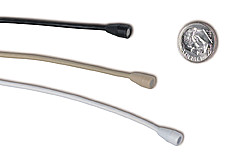 Shure's
new WL50 lavalier microphone series sets a new standard for miniature
microphones. Visually unobtrusive, the WL50s are ideal for theater, television
broadcast, video/film, and event production. Designed for applications that
require minimal visibility without compromising sound quality, these microphones
are available individually, as well as with the Shure UHF,
UC, SC and LX Wireless Systems.
Shure's
new WL50 lavalier microphone series sets a new standard for miniature
microphones. Visually unobtrusive, the WL50s are ideal for theater, television
broadcast, video/film, and event production. Designed for applications that
require minimal visibility without compromising sound quality, these microphones
are available individually, as well as with the Shure UHF,
UC, SC and LX Wireless Systems.
Features
| Subminiature size (5.8 mm diameter x 11 mm height) | |
| Electret condenser cartridge | |
| Omnidirectional pattern | |
| Two termination options: TA4F connector (fits directly into Shure
wireless transmitters), or unterminated (bare wire) | |
| Two sensitivities available: |
| Standard:
-40 dBV/Pa (for speech applications) | |
| Reduced:
-50 dBV/Pa (10 dB more headroom for theater applications) |
| Silver
mesh cap provides a 4 dB boost in the 8-18 kHz range - typically used in
applications that require a microphone to be head-mounted | |
| Gold
mesh cap provides a 10 dB boost centered at 12 kHz - typically used in
applications that require a chest-worn microphone |
Model
Variations
|
WL50B |
Black,
TA4F Connector |
|
WL50T |
Beige,
TA4F Connector |
|
WL50W |
White,
TA4F Connector |
|
WL50B-LO |
Black,
TA4F Connector, reduced sensitivity |
|
WL50T-LO |
Beige,
TA4F Connector, reduced sensitivity |
|
WL50BX |
Black,
less connector |
|
WL50TX |
Beige,
less connector |
|
WL50WX |
White,
less connector |
|
WL50BX-LO |
Black,
less connector, reduced sensitivity |
|
WL50TX-LO |
Beige,
less connector, reduced sensitivity |
|
MC50B |
Black, 5
foot (1.5 m) attached cable with in-line preamplifier |
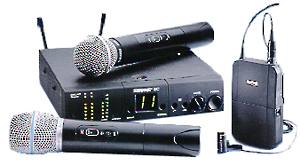
Make it Easy on Yourself with
Shure UC Wireless.
The new Shure UC gives you more
of what you want most in a UHF wireless microphone system.
Its flexibility makes it the
ideal choice for a wide range of applications. Its ease of operation eliminates
the extended learning curve you'd expect from such a high-performance system.
Its reliability assures that you're in for years of trouble-free performance.
And its name gives you the peace of mind that comes from knowing you're dealing
with "The Sound of Professionals ... Worldwide®."
In other words, the UC Wireless
System lets you make it easy on yourself.
What more could you ask?
All The Right Features
Shure's new UC Wireless System
offers the kind of sound-enhancing, timesaving features professional users want
most, including:
| The advantages of UHF operation, for minimal interference. | |
| Frequency agility, which allows you to quickly and easily change
frequencies to avoid interference. Choose from over 100 frequencies
(international versions may vary). | |
| Up to 16 system simultaneous operations (international versions may
vary). | |
| The versatility of interchangeable microphone elements from the
world's most renowned collection. Choose from a selection of body-pack
microphones (lavalier, headworn, instrument or cable) and handheld
microphones (SM58, Beta 58A, SM87A or Beta 87A). | |
| MARCAD® diversity circuitry provides superior reception
and exceptional freedom from dropouts. | |
| Space-saving, half-rack receiver design. | |
| Built-in adjustable EQ on receiver tailors frequency response to
fine tune your system. | |
| Tone key squelch circuitry prevents unwanted noise from entering the
system. | |
| Noise squelch circuitry virtually eliminates annoying noise bursts. | |
| TTL logic output terminal on receiver features removable block
connector to control external devices based on the status of the UC system. |
In short, the Shure UC Wireless
System is the professional solution for a wide range of applications.
Easy to Operate
The new Shure UC Wireless is
extremely user friendly and intuitive.
| Easy-to-use screwdriver adjustable controls on transmitter and
receiver. | |
| Extensive LED metering on receiver front panel keeps user informed
of the status of important functions, including: |
·
| Dual
RF meters and Antenna Diversity LEDs that make it easier to identify
"dead spots" in the performing area. | |
| Audio
meter that monitors received audio level and helps optimize transmitter
gain setting. | |
| Group/Channel
display that indicates current group and channel settings and facilitates
easy setup of multiple channel systems. | |
| Low
transmitter battery warning LED. |
Legendary Shure Reliability
When it comes to reliability, the
new UC Wireless System is built to deliver years of problem-free performance.
| Rugged
design and construction of receiver, handheld and body-pack resists
day-to-day abuse, year after year. | |
| Shure's
proven record of microphone and transmitter performance is legendary. | |
| Diagnostic
features alert user to potential problems before they occur. |
Accessory Enhancements
The Shure UC Wireless comes with
everything you need to operate the system. But you can enhance the system to new
levels with a choice of accessories (all of which are available separately),
including:
| UA101
Remote Audio Mute Switch for body-pack transmitter. Allows external audio/RF
muting of body-pack during performance. | |
| UA220
Passive Antenna Splitter/Combiner Kit. Combines two diversity receivers
while using only two antennas or allows four antennas to be fed into one
diversity receiver. | |
| UA845
Antenna/Power Distribution System. Combines up to five UC4 receivers and
powers up to four with only two antennas. | |
| UA500
Remote Mount Antenna Kit. Includes mounting bracket and 1/2 wave antenna for
receiver. | |
| UA600
Front Mount Antenna Kit for receiver. |
A Tradition of Value
The UC Wireless is the latest in
Shure's full line of proven wireless systems and other products designed for the
installed sound professional. Each one comes with unparalleled service and
support. Which is precisely what you've come to expect from 70 years of
leadership in state-of-the-art sound reinforcement products.
Shure Antenna Distribution UA845:
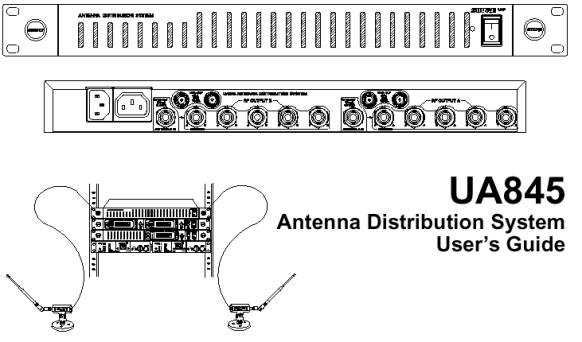
Expandability. The UA845 UHF
Antenna Distribution
System
is designed for large UHF wireless systems.
Each
unit allows up to four wireless receivers to use the
same
two antennas, and the CASCADE ports allow
connection
to a fifth receiver or a second UA845.
Compatibility. The UA845 is
compatible with all Shure
wireless
microphone receivers operating within a com-patible
frequency
range (see UHF Carrier Frequency
Ranges
in the Specifications section).
CASCADE Ports. Two 50 W,
BNC-type antenna CAS-CADE
ports
allow an additonal UA845 unit or a fifth
wireless
receiver. A large wireless system can be run
off
of a single pair of antennas.
Power OUTPUT and OUT Connectors. Up to five (5)
U4
receivers can be daisy-chained and powered from a
single
source via the Power OUTPUT connectors. Up
to
four (4) UC4 receivers can be powered from the
UA845
using the 12 Vdc OUT connectors.
Low Noise and Intermodulation Distortion. The
UA845
maintains clean signals with minimal distortion.
Insertion Loss Compensation. Whenever
a signal is
split
to multiple output ports, there is a loss in signal
strength.
The UA845 amplifies signals to compensate,
ensuring
a strong signal to the receivers.
Front-Mounted Antennas. The
UA845 comes with
hardware
to front-mount the antennas, if desired.
Rack
Mounts:
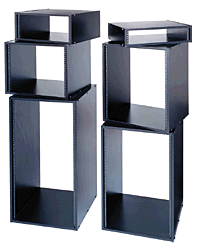
|
Black Laminate Racks |
|
|
|
|||||||||||||
|
Part # |
Racking Height |
Depth
|
Overall
Height |
Power
Strip |
||||||||||
|
RK2 |
3 1/2" (2 space) |
16" |
5" |
|
||||||||||
|
RK4 |
7" (4 space) |
16" |
8
1/2" |
|
||||||||||
|
RK8 |
14" (8 space) |
16" |
15
1/2" |
|
||||||||||
|
RK12 |
21" (12 space) |
16" |
22
1/2" |
|
||||||||||
|
RK16 |
28" (16 space) |
16" |
29
1/2" |
S* |
||||||||||
|
RK20 |
35" (20 space) |
16" |
36
1/2" |
S |
||||||||||
|
BRK8 |
14" (8 space) |
18" |
15
1/2" |
|
||||||||||
|
BRK12 |
21" (12 space) |
18" |
22
1/2" |
|
||||||||||
|
BRK16 |
28" (16 space) |
18" |
29
1/2" |
S* |
||||||||||
|
BRK20 |
35" (20 space) |
18" |
36
1/2" |
S |
||||||||||
BSS 9088LL SoundWeb:
6.1 9088
Networked Signal Processor
![]()
The 9088 Networked Signal Processor forms the heart of the Soundweb system. In a single rack space unit, it offers 8 analogue audio inputs, 8 analogue audio outputs, 160 MIPS of digital signal processing, a pair of network jacks, and a variety of control options.
The front panel of the
9088 has a number of LEDs to allow a quick view of activity on the audio inputs
and on the network. It also has a mini-DIN connector for an RS-232 serial port:
this is normally used to connect a PC for system setup and control
![]()
The rear panel contains the audio inputs and outputs and the network jacks. It also contains a second RS-232 port, which is normally used for control from an external controller such as AMX or Crestron. Finally, it contains a control connector: see section 4 Control options for a description of how this is used. Both control i/o and analogue i/o connections are made via "Phoenix" style two-part screw terminals; the female connectors are shipped with the Soundweb unit, so installation can be made with no soldering and no extra connectors to buy.
The 9088 contains two preamplifier cards for the analogue inputs: each card handles four of the inputs. Two types of card are available: the line card and the mic/line card. The line card gives a choice of two gain settings: 0 dB and 12 dB (intended as a pro/consumer switch). The mic/line card provides a range of gain settings from 0 dB to 72 dB, together with phantom power and phase reverse. In all cases, each input can be switched individually.
The analogue outputs are equipped with analogue attenuation after the DAC stage. If the unit is used at anything lower than its full output level, it makes sense to apply the final gain reduction in the analogue domain: in this way, the DAC noise is also attenuated and the signal to noise ratio is kept at a maximum.
The core of the 9088 contains two Motorola 56301 DSP chips, running at 80MHz each and thus providing a total of 160 MIPS of DSP. There is also a block of dynamic RAM allowing a total of 11 seconds of audio delay. The main control processor is a Motorola 68000-series CPU, which runs a real-time multi-tasking operating system; this CPU takes care of system operation and interfacing and performs all the necessary housekeeping functions. Finally, the core contains a flash EPROM (see section 5 Flash EPROM storage), in which is stored all of the software to run the unit, and also the unit's configuration.
Meyer Speakers:
CQ™-2 Self-Powered Loudspeaker System50°H 40°V |
|
FeaturesHigh power |
ApplicationsTheatre PA systems |
![]()
The CQ™ products are self-powered reinforcement loudspeakers that come in either a high Q or low Q configuration. As a high Q loudspeaker, the CQ™-2 covers 50°H x 40°V, while the CQ™-1 covers 80°H x 40°V. The amplifier and control electronics are fully contained within the compact speaker enclosures. "CQ" stands for "Constant Q," meaning that the distribution of acoustic energy is very evenly distributed over the coverage pattern in both the horizontal and vertical axes, while the energy outside the coverage area is low. This provides extremely tight control and predictable results for venues in which acoustic spill-over is to be avoided.
The CQ's incorporate the Intelligent AC™ system, which performs automatic voltage selection, EMI filtering, soft current turn-on, and surge suppression. All that is required for full operation is the application of AC power and an audio source. The unit's TruPower Limiting™ driver protection technology offers longer driver component life when units are run at extreme levels for extended periods. The cooling, power supply, and amplifier subsystems are all built for maximum efficiency and reliability. However, if servicing is required, it is facilitated by the modular design. The units can be fitted with the Remote Monitoring System (RMS™), which allows the operators to monitor such system parameters as signal and power levels, limiter activity, amplifier heatsink temperature, and cooling fan status.
PSW-2 Self-Powered
|
|
||||||
|
FeaturesArrayable and Flyable Subwoofer
|
ApplicationsFlyable Subwoofer Arrays OptionsRMS ™ Network |
![]()
The PSW-2 is a self-powered, dual-amplified, 4th order bass-reflex subwoofer which is arrayable and flyable (with optional rigging). The dimensions of its trapezoidal cabinet are identical to those of the MSL-4. The unit incorporates twin 15" drivers, has a frequency response of 35 Hz to 120 Hz and is phase-corrected.
The amplifier, controller, power supply and cooling subsystems are integrated into a lighweight module, service accessible at the back of the enclosure. Self-contained electronics eliminate the need for equipment racks. The PSW-2 is compact for efficient transport and setup.
The PSW-2 power supply incorporates the Intelligent AC ™ system, which performs automatic voltage selection, EMI filtering, soft current turn-on and surge suppression. Simply connect a signal source and plug into power anywhere worldwide and the unit is fully operational.
The amplifier unit is equipped with TruePower ™ Limiter technology, which maximizes speaker protection reliability and component life. This breakthrough in speaker control also results in higher SPL at all frequencies and increased available headroom. Long term power compression, typically 3-6 dB in conventional systems, is less than 1 dB. Maximum SPL capability remains constant even during operation at high levels for extended periods.
PSW-2 performance can be supervised using the Remote Monitoring System (RMS ™). This enables users at a computer terminal to monitor such parameters as limiting activity, power output, voltage, temperature, fan speed and driver status.
For more information, read this article on Powered Subwoofers.
UPA-1P & 2P Self-Powered UltraSeries™100°H 40°V (UPA-1P; -6 dB
points) |
|
FeaturesIntegrated control electronics and amplifiers |
|
![]()
The Meyer UPA-P Series self-powered loudspeakers (UPA-1P, UPA-2P) are more than powered versions of the Meyer UPA-C Series (UPA-1C, UPA-2C). The UPA-P Series features phase-corrected electronics that produce flat acoustical phase and amplitude responses, resulting in exceptional system impulse response and precise imaging. Despite the inclusion of amplification and control electronics, the UPA-P is the same size as, and only 10 lb. heavier than the UPA-C. Additionally, the UPA-P's advanced horn designs achieve a consistent polar response and smooth arraying behavior.
The beamwidth of a horn is the angle at which the sound pressure at a given frequency decreases to half (-6 dB) its on-axis amplitude. Existing technologies produce horns whose beam width varies over the operating frequency range. These horns also display nonuniform frequency response within, and significant side lobe energy outside their beam width. Both undesirable characteristics, particularly prevalent for horns with a wide beamwidth, make array design extremely problematic.
The UPA-P horns exhibit constant Q: the beamwidth remains consistent across the horn's operating frequency range in both the vertical and horizontal planes. The UPA-2P uses the same horn as the UPA-2C: the original design achieved constant Q for its narrow beam width (45°H x 45°V). Meyer Sound developed the UPA-1P horn in an anechoic chamber by measuring coverage patterns using angular and frequency resolutions of 1° and 1/36 octave, respectively. The UPA-1P horn provides a much wider horizontal, and slightly narrower vertical beam width (100°H x 40°V) than the UPA-2P. Both speakers share the following remarkable attributes:
| uniform frequency response within the beamwidth | |
| rapid and uniform amplitude | |
| attenuation for all frequencies outside the beamwidth | |
| minimal side lobes |
The UPA-P Series is ideally suited for small PA applications requiring complete coverage with a compact, high-powered system, and also make excellent under-balcony, down-fill, and keyboard speakers.
The UPA-P's integrated electronics employs the Intelligent AC power supply, which auto-selects the correct operating voltage (facilitating international use), suppresses high voltage transients, and provides soft-start power-up (eliminating high inrush current).
The UPA-P can be equipped to operate with the Remote Monitoring System™ (RMS) network and software application. The UPA's are shipped with one of two audio input and control options. The Basic module contains an XLR input and a loop connector.
The second module provides features that facilitate array building and integration into full-range systems without incurring the cost of external processors. These interchangeable modules can be installed in the field with a Phillips screwdriver. RMS displays signal and power levels, driver and cooling fan status, limiter activity, and amplifier temperature for all speakers in the network on a Windows™-based PC.
|
|
UPM-1P Self-Powered Loudspeaker100°H 100°V |
|
|
FeaturesCompact size |
![]()
The UPM-1P is a compact, self-powered professional sound reinforcement
loudspeaker system. Versatile and powerful, its bi-amped, three-way design
incorporates dual 5-inch low/mid transducers, a 1-inch titanium dome HF driver
on a symmetrical 100° horn, a two-channel power amplifier, and Meyer Sound's
proprietary phase-corrected active processing circuits.
The UPM-1P is ideally suited to applications requiring high sound pressure levels, extremely low distortion, and uniform directional control. Stand-alone, the UPM-1P will provide vocal range reinforcement as a small PA system, in under-balcony, front- or side-fill applications. A full-range system can be created with the addition of a separate optional subwoofer.
Like all Meyer self-powered loudspeaker systems, the UPM-1P exhibits superior performance across virtually all parameters. Because the amplifiers and control electronics are optimized for each driver, the system is able to produce more power with a flatter response and lower distortion. The self-powered concept simplifies installation, eliminates amplifier racks and external drive processing, and can create extensive distributed systems free from the signal losses imposed by long loudspeaker cable runs or 70/100V wiring schemes.
UPM-1P's constant directivity HF horn affords a 100° beam width, and sophisticated phase-correction circuitry assures true point-source performance without the off-axis cancellation effects that plague customary dual-woofer designs. Two MS-5 low/mid-frequency transducers are driven in parallel to take advantage of their combined acoustic output. To prevent destructive interference due to comb filtering effects in the critical mid-band frequencies, one of the drivers is passively rolled off above 500Hz. Two channels of power amplification are provided, along with an active crossover, driver protection voltage limiters, and frequency and phase response alignment circuitry. A laser-trimmed differential input stage affords superior common-mode rejection to allow signal runs through a simple twisted pair cable. Rear panel LEDs indicate AC power and driver protection limiting. The UPM-1P's integral power supply suppresses high voltage transients. Two PowerCon AC connectors are provided to facilitate AC looping.
The rugged cabinet is coated with a textured black finish. It has three 3/8"-16 threaded recessed nut plates, and may be mounted on a stand. Optional mounting hardware is available. The UPM-1P easily integrates with the Remote Monitoring System™ (RMS) network and software. RMS displays signal and power levels, driver and cooling fan status, limiter activity, and amplifier temperature on a remote PC. The UPM-1P can be supplied with either the standard audio input module incorporating looping XLR connectors, or an alternate that adds attenuation and a polarity switch.
